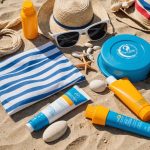Optimal Sunscreen Application Timing for UK Beach Lovers: Maximize Your Beach Day Protection!
As the sun begins to shine brighter in the UK, whether you’re heading to the beaches of Cornwall, the lakes of the Lake District, or simply enjoying a sunny day in your backyard, protecting your skin from the sun’s harmful rays is crucial. Here’s a comprehensive guide to help you understand the best times and methods for applying sunscreen to ensure you have a safe and enjoyable summer.
Understanding the Importance of Sun Protection
Before we dive into the timing and application tips, it’s essential to understand why sun protection is so vital. The sun’s UV rays, both UVA and UVB, can cause significant damage to your skin, leading to sunburn, premature aging, and even skin cancer.
Also to discover : Unlocking Radiant Skin: The Impact of Probiotics on Skin Health for Residents in the UK
“Sun protection should be always something you think about, especially if you’re jetting off on a sunny holiday,” emphasizes a travel blogger who has learned the hard way about the importance of sun protection.
Choosing the Right Sunscreen
SPF and Broad Spectrum Protection
When selecting a sunscreen, it’s crucial to choose one that offers broad spectrum protection and a high SPF. Here are some key points to consider:
Topic to read : Unveiling the Power of Antioxidants: Their Impact on Combating Age-Related Illnesses in the UK
- SPF 30 or Higher: Opt for a sunscreen with an SPF of at least 30. This provides adequate protection against UVB rays, which are a primary cause of sunburn and skin cancer.
- Broad Spectrum: Ensure the sunscreen protects against both UVA and UVB rays. UVA rays penetrate deeper into the skin, causing aging and damage, while UVB rays are more associated with sunburn.
Non-Greasy and Reef-Safe Options
- Non-Greasy Sunscreens: For those who prefer not to look like they’ve been “varnished,” non-greasy sunscreens are a great option. Brands like La Roche Posay offer matte effect sprays that are perfect for active days.
- Reef-Safe Sunscreens: If you’re planning a beach trip, consider using reef-safe sunscreens. These sunscreens avoid chemicals like oxybenzone and octinoxate, which can harm coral reefs. Naked Sundays and Sky and Sol offer excellent reef-safe options.
Best Times to Apply Sunscreen
Before Heading Out
- Apply Early: Apply sunscreen at least 15-30 minutes before you head out into the sun. This allows the ingredients to bind to your skin, providing optimal protection.
- Reapply Often: Reapply sunscreen every two hours or immediately after swimming or sweating. This ensures continuous protection against the sun’s rays.
Cloudy Days and Cold Destinations
- Cloudy Days: Don’t let cloudy skies fool you. UVA and UVB rays can still pass through clouds, causing sunburn. Apply sunscreen even on cloudy days.
- Cold Destinations: In snowy or cold destinations, the Albedo Effect can increase your exposure to UV rays. Make sure to pack high SPF sunscreen and apply it frequently.
Detailed Application Tips
Here are some detailed tips to help you apply sunscreen effectively:
Application Timing
| Time of Day | Sun Intensity | Application Tips |
|---|---|---|
| Before 10 AM | Lower | Apply sunscreen 15-30 minutes before heading out. |
| 10 AM – 2 PM | High | Avoid direct sun exposure. Reapply sunscreen every two hours. |
| After 2 PM | Lower | Continue to reapply sunscreen every two hours. |
Key Application Areas
- Face and Neck: Use a broad spectrum sunscreen with at least SPF 30. Apply it evenly, making sure to cover all exposed areas, including the ears and back of the neck.
- Body: Apply sunscreen to all exposed skin, paying special attention to areas like the shoulders, back, and legs.
- Children: For children, use child-friendly sunscreens and apply them liberally. Make sure to cover all exposed skin and reapply every two hours.
Additional Protective Measures
- Clothing and Accessories: Wear protective clothing, including hats and sunglasses, to add an extra layer of protection.
- Seek Shade: When the sun is at its peak (usually between 10 AM and 2 PM), seek shade to reduce direct exposure to UV rays.
Practical Insights and Actionable Advice
Checking Expiration Dates
- Expiration Dates: Sunscreen can lose its potency over time. Always check the expiration date and follow the instructions on the bottle to ensure you’re getting the best protection.
Base Tan Myth
- Base Tan: A base tan is not a reliable form of sun protection. It offers minimal protection against UV rays and can still lead to sunburn and skin damage.
Real-Life Examples and Anecdotes
The Cloudy Day Burn
“I once got severely burned on a cloudy day while hiking in the mountains. I didn’t apply sunscreen because I thought the clouds would protect me. Now, I always apply sunscreen, regardless of the weather,” shares a seasoned traveler.
The Importance of Reapplication
“During a summer beach trip, I forgot to reapply sunscreen after a swim. By the end of the day, my skin was lobster-red. Now, I set reminders to reapply every two hours to avoid such mistakes,” says a beach enthusiast.
Protecting your skin from the sun is a year-round goal, but it becomes especially critical during the summer months. By choosing the right sunscreen, applying it at the right times, and taking additional protective measures, you can enjoy your beach days without worrying about the harmful effects of the sun.
Here’s a quick summary of the key points:
- Choose a high SPF, broad spectrum sunscreen.
- Apply sunscreen 15-30 minutes before heading out.
- Reapply every two hours or after swimming or sweating.
- Use additional protective measures like clothing and shade.
- Check expiration dates and avoid relying on a base tan.
By following these tips, you can ensure your skin remains protected and healthy, allowing you to enjoy the sun without the risk of damage or cancer. So, the next time you head out to soak up some sun, make sure you’re well-prepared with the best sun protection strategies.











